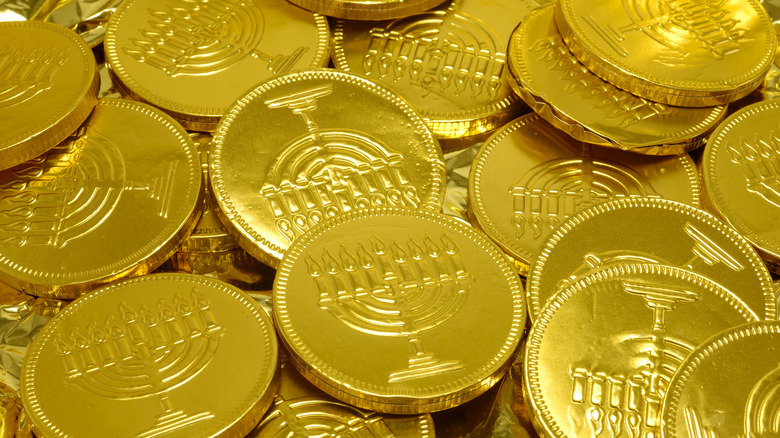The Historical Significance Of Chocolate Gelt During Hanukkah
For many Jewish children, chocolate coins called gelt play an important role in the Jewish holiday Hanukkah. Typically, parents give these coins to their children as part of the festivities, but chocolate gelt is more than just a sweet treat. As with many traditions, it is steeped in historical significance. Chocolate gelt is actually a cultural memory that may stretch back thousands of years to years to the origin of the holiday.
Many believe that chocolate gelt relates to the Maccabean Revolt in 167 to 160 BCE. During the revolt, the Jewish people rose up against the Seleucid Empire, which controlled Judea during the time. They took back and reconsecrated the Temple of Jerusalem, which became the basis for the Hanukkah celebration. The coins and treasure shared among the Jewish people during this reconsecration ceremony were the original gelt. After the revolt, ancient Israel became religiously and politically independent and began minting its own coinage as a result. The modern-day chocolate is a celebration of this ancient accomplishment that's been echoed forward through the years.
Initially, gelt was real money that would be given to adults rather than children during the Hanukkah celebration. However, as with many modern-day traditions, gelt became more of a symbolic gesture that evolved over time.
When did gelt become chocolate?
In Eastern European shtetls, or Jewish villages, Hanukkah gelt was a way for Jewish families to pay a little extra — essentially a tip — for services rendered during the holiday season. Judaic Studies professor Gina Glassman told NPR that families might give gelt to their butcher for kosher meat for their holiday celebrations or to their Jewish studies teacher. "And you'd even have a guy employed to bang on people's doors to wake them up for prayers," she said. "Hanukkah was a time you paid these men a little bit extra."
Things began to change in the late 1800s. Rather than giving gelt as an end-of-the-year tip to teachers and other workers, families started giving it to children during Hanukkah celebrations. While Glassman characterized the change in customs as "mysterious," author Michael Leventhal suggests that it was the result of parents literally and figuratively sweetening the prospect of children doing their studies. According to Leventhal, the philosopher Maimonides even described gelt as "an incentive for [children] to study Torah properly."
By the 1920s, traditions shifted yet again and real coins were exchanged for chocolate gelt, possibly inspired by Belgium and the Netherlands' tradition of gifting chocolate coins. New York candy company Loft's Candies became the first to make chocolate gelt for the holiday, soon followed by Barton's Candy and other candy manufacturers, cementing chocolate gelt's importance with the holiday.
How gelt is used today
In the modern day, chocolate gelt has become part of many Jewish families' festivities. A popular game for the holiday season involves chocolate gelt and a dreidel, a spinning top with four letters from the Jewish alphabet. Similar in some aspects to poker, players spin their dreidel hoping to land on the letter Gimel, which will allow them to win the pot of gelt. While some within the Jewish community find that the practice of essentially gambling with chocolate gelt projects a negative stereotype, that criticism ignores the original intention for gelt, which some still hold onto.
Jewish organizations like The Fifth Night encourage Jewish families to be charitable, particularly on the fifth night of Hanukkah, whose focus is mitzvahs, or good deeds. The organization encourages families with school-age children to donate toys and other supplies to families who are less fortunate, with the aim of reminding families to give rather than receive gifts. Some organizations even use chocolate gelt as the centerpiece for their fundraising efforts and charitable giving year-round.


